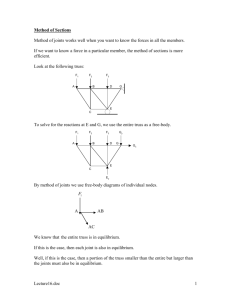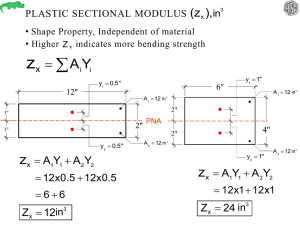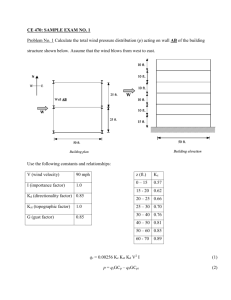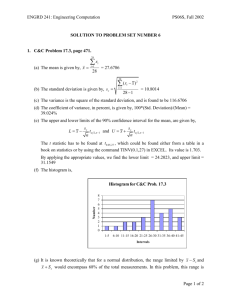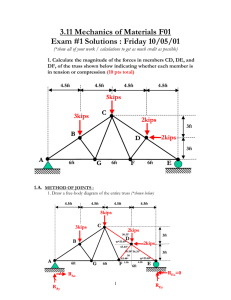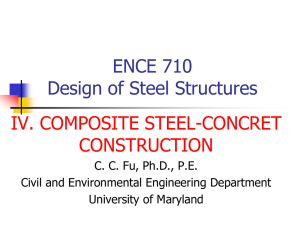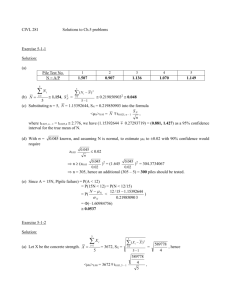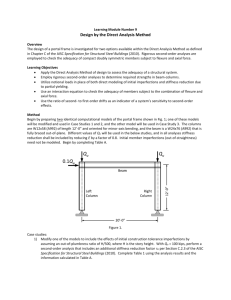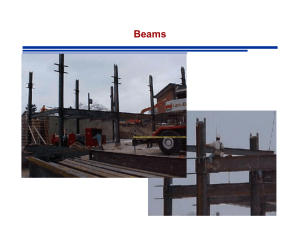26 Worked Solutions
advertisement
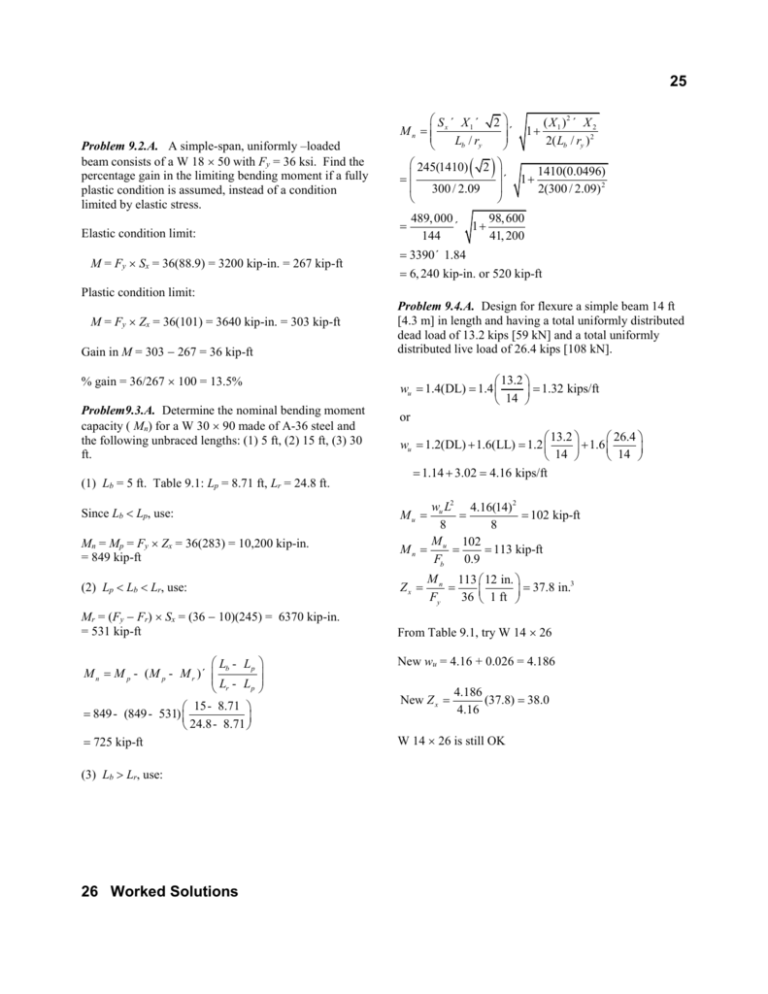
25 Problem 9.2.A. A simple-span, uniformly –loaded beam consists of a W 18 50 with Fy = 36 ksi. Find the percentage gain in the limiting bending moment if a fully plastic condition is assumed, instead of a condition limited by elastic stress. S ´ X1 ´ 2 Mn x ´ Lb / ry ´ 245(1410) 2 300 / 2.09 Elastic condition limit: M = Fy Sx = 36(88.9) = 3200 kip-in. = 267 kip-ft 489, 000 ´ 144 1 1 1 ( X 1 )2 ´ X 2 2( Lb / ry ) 2 1410(0.0496) 2(300 / 2.09) 2 98, 600 41, 200 3390´ 1.84 6, 240 kip-in. or 520 kip-ft Plastic condition limit: M = Fy Zx = 36(101) = 3640 kip-in. = 303 kip-ft Gain in M = 303 267 = 36 kip-ft % gain = 36/267 100 = 13.5% Problem9.3.A. Determine the nominal bending moment capacity ( Mn) for a W 30 90 made of A-36 steel and the following unbraced lengths: (1) 5 ft, (2) 15 ft, (3) 30 ft. (1) Lb = 5 ft. Table 9.1: Lp = 8.71 ft, Lr = 24.8 ft. Problem 9.4.A. Design for flexure a simple beam 14 ft [4.3 m] in length and having a total uniformly distributed dead load of 13.2 kips [59 kN] and a total uniformly distributed live load of 26.4 kips [108 kN]. 13.2 wu 1.4(DL) 1.4 1.32 kips/ft 14 or 13.2 26.4 wu 1.2(DL) 1.6(LL) 1.2 1.6 14 14 1.14 3.02 4.16 kips/ft Mn = Mp = Fy Zx = 36(283) = 10,200 kip-in. = 849 kip-ft wu L2 4.16(14) 2 102 kip-ft 8 8 M 102 Mn u 113 kip-ft Fb 0.9 (2) Lp Lb Lr, use: Zx Mr = (Fy Fr) Sx = (36 10)(245) = 6370 kip-in. = 531 kip-ft From Table 9.1, try W 14 26 Since Lb Lp, use: Lb - Lp M n M p - ( M p - M r )´ L - L p r 15 - 8.71 849 - (849 - 531) 24.8 - 8.71 725 kip-ft (3) Lb Lr, use: 26 Worked Solutions Mu M n 113 12 in. 3 37.8 in. Fy 36 1 ft New wu = 4.16 + 0.026 = 4.186 New Z x 4.186 (37.8) 38.0 4.16 W 14 26 is still OK Problem 9.4.C. A beam of 15-ft [4.6 m] length has three concentrated loads of 6 kips, 7.5 kips, and 9 kips at 4 ft, 10 ft, and 12 ft [26.7 kN, 33.4 kN, and 40.0 kN at 1.2m, 3 m, and 3.6 m], respectively, from the left-hand support. Design the beam for flexure. Mn M u 78.5 87.2 kip-ft Fb 0.9 Zx M n 87.2(12) 29.1 in.3 Fy 36 Pu = 1.2(dead load) + 1.6(live load) From Table 9.1, try a W 12 22 Live loads: Pu1 = 1.6(6) = 9.6 kips, Pu2 = 1.6(7.5) = 12 kips, Pu3 = 1.6(9) = 14.4 kips. Add weight of beam as a distributed load: From analysis of the beam, Mu = 81.6 kip-ft Mn Zx M u 81.6 90.7 kip-ft Fb 0.9 M n 90.7(12) 30.2 in.3 Fy 36 From Table 9.1, select: W 10 26 wu = 1.2(0.022) = 0.0264 kip/ft M u 0.385 kip-ft (under point load) New total Mn = 87.6 kip-ft Zx Add weight of beam as a uniformly distributed load. wu = 1.2(dead load) = 1.2(0.026) = 0.0312 kips/ft Mu wu L2 0.0312(15)2 0.88 kip-ft 8 8 Mn M u 0.88 0.98 kip-ft Fb 0.9 New total Mn = 90.7 + 0.98 = 91.69 kip-ft New required Zx = 30.5 in.3 , selection still OK. Problem 9.4.E. Design for flexure a beam 12 ft [3.6 m] in length, having a uniformly distributed dead load of 1 kip/ft [14.6 kN/m], a uniformly distributed live load of 1 kip/ft [14.6 kN/m], and a concentrated load of 8.4 kips [37.4 kN] a distance of 5 ft [1.5 m] from one support. M u 0.385 0.427 kip-ft Fb 0.9 Mn M n 87.6(12) 29.3 in.3 . W 12 ´ 22 still OK Fy 36 Problem 9.4.G. A steel beam 16-ft [4.9 m] long has a uniformly distributed dead load of 100 lb/ft [1.46 kN/m] and a uniformly distributed live load of 100 lb/ft [1.46 kN/m] extending to 10 ft [3 m] from the left support. In addition, there is a concentrated live load of 8 kips [35.6 kN] at 10 ft [3 m] from the left support. Design the beam for flexure. wu = 1.2(DL) + 1.6(LL) = 1.2(0.1) + 1.6(0.1) = 0.28 kips/ft Pu = 1.6(8) = 12.8 kips From the beam analysis: Mu = 54.6 kip-ft (under the point load) Mn M u 54.6 60.7 kip-ft Fb 0.9 Zx M n 60.7(12) 20.2 in.3 Fy 36 wu = 1.4(DL) = 1.4(1) = 1.4 kips/ft or, wu = 1.2(DL) + 1.6(LL) = 1.2(1) + 1.6(1) = 2.8 kips/ft From Table 9.1, try W 10 19 Pu = 1.4(DL) = 1.4(8.4) = 11.9 kips Beam weight: wu = 1.2(0.019) = 0.0228 kips/ft From the beam load analysis: Adjusted Zx = 20.5 in.3, selection still OK Mu = 78.5 kip-ft (under the point load) 27 Problem 9.4.I. A cantilever beam is 12 ft [3.6 m] long and has a uniformly distributed dead load of 600 lbs/ft [8.75 kN/m] and a uniformly distributed load of 1000 lbs/ft [14.6 kN/m]. Design the beam for flexure. wu = 1.2(DL) + 1.6(LL) = 2.32 kips/ft Mu wu L2 2.32(12) 2 167 kip-ft 2 2 Mn M u 167 186 kip-ft Fb 0.9 Zx M n 186(12) 61.9 in.3 Fy 36 From Table 9.1, try W 16 36 Lb - Lp M n M p - (M p - M r ) L - L p r 6 - .71 462 - (462 - 286) 457 kip-ft 17.2- 5.71 Close but OK, use the W 24 62. (b) Lb = 10 ft. From Table 9.1, try a W 24 68. Additional weight makes the required Mn = 455 kip-ft. Lb - Lp - Mr L - L p r 10- 7.50 =480- (849- 303) 451 kip-ft 22.8- 7.50 Mn M p - M p For beam weight, wu = 1.2(0.036) = 0.0432 kips/ft As this is less than the required value, the shape does not work. Use a W 16 77 or a W 24 76. New Mn = 190 kip-ft, Zx = 63.3 in.3, selection still OK (c) Lb = 15 ft. Based on previous work, try a W 24 76. Problem 9.5.A. A W shape is to be used for a uniformly loaded simple beam carrying a total live load of 50 kips [222 kN] and a total dead load of 22 kips [98 kN] on a 30 ft [9.2 m] span. Select the lightest weight shape for unbraced lengths of (a) 6 ft [1.83 m], (b) 10 ft [3.05 m], (c) 15 ft [4.57 m]. Wu = 1.2 (DL) + 1.6 (LL) = 1.2(22) + 1.6(50) = 106.4 kips Mu WL 106.4(30) 399 kip-ft 8 8 Mn M u 399 443 kip-ft Fb 0.9 Zx M n 443(12) 148 in.3 Fy 36 (a) Lb = 6 ft. From Table 9.1, a W 24 62 is lightest (Lp) is 5.71 ft or less (Lb). Try this shape and check for buckling. Adding the weight of the beam, new values are: Wu = 108.6 kips, Mn = 452 kip-ft Check for: LpLbLr , 5.71617.2 15- 8 M n 600- (600- 381) 500 kip-ft 23.4- 8 Which indicates that the shape is adequate. (Note: This process is really laborious. It makes a case for using some aid to shortcut the process. One aid is the use of a computer program. Another aid consists of the series of graphs similar to Fig. 9.6 which are provided in the AISC Manual (Ref. 5). 28 Worked Solutions Problem 9.5.C. A W shape is to be used for a uniformly loaded simple beam carrying a total live load of 50 kips [222 kN] and a total dead load of 22 kips [98 kN] on a 30 ft [9.14 m] span. Select the lightest weigh shape for unbraced lengths of (a) 6 ft; (b) 10 ft; (c) 15 ft. Which indicates that the chosen shape is OK. Wu 1.2( DL)1.6( LL) 1.2(22) 1.6(50) 106.4 kips 15- 8 M n 600- (600- 381) 501 kip-ft 23.4- 8 Mu WL 106.4(30) 399 kip-ft 8 8 Mn M u 399 443 kip-ft Fb 0.9 Zx M n 443(12) 148 in.3 Fy 36 (c) unbraced length = 15 ft Try the W 24 76, requires Mn = 454 kip-ft. Which indicates that the shape is still OK for this unbraced length. Problem 9.6.A, B, C. Compute the shear capacity (vVn) for the following beams of A36 steel: A, W 24 84, C, W 10 19. Case 1: h 418 69.7 tw 36 Case 2: h 523 87.2 tw 36 From Table 9.1, lightest shape is a W 24 62 if unbraced length is 5.71 ft or less. (a) unbraced length Lb = 6 ft Try the W 24 62 for the case of LpLbLr, or 5.71617.2. Then Add weight of beam at 1.2(62 30) = 2.23 kips. A: From Table A.3 = d = 24.1 in., tw = 0.470 in., tf = 0.770 in. New required Mn = 453 Kip-ft h = d 2(tf) = 24.1 2(0.770) = 22.56 Lb - L p M n M p - (M p - M r ) L - L p r 6 - 5.71 462 - (462 - 286) 17.2 - 5.71 458 kip-ft As this is greater than the required value, the shape chosen is OK. (b) unbraced length Lb = 10 ft Same case as (a). Trials will show W 24 62, and 68 do not work. Try W 24 76. New total Wu = 109.1 kips. New required M n 109.1 (443) 454 kip-ft 106.4 h 22.56 48.0 tw 0.47 Case 1 condition Aw = d tw = 24.1 0.470 = 11.33 in.2 vVn = 0.9 0.6 36 11.33 = 220 kips C: h = 10.24 2(0.395) = 9.45 in. h 9.45 37.8, Case 1 tw 0.25 Aw = 10.24 0.25 = 2.56 in.2 vVn = 0.9 0.6 36 2.56 = 49.8 kips 10- 8 M n 600- (600- 381) 572 kip-ft 23.4- 8 29 Problem 9.7.A-D. Find the maximum deflection in inches for the following simple beams with uniformly distributed load. Find the values using: (a) the equation for the beam: and (b) the curves in Fig. 9.11. A: W 10 33, span = 18 ft, service load = 1.67 klf. 5wL4 5(1.67 /12)(18´ 12) 4 0.794 in. (a) D 384 EI 384(29, 000)(171) (b) = 0.9 in. C: W 18 46, span = 24 ft, service load = 2.29 klf 5wL4 5(2.29 /12)(24´ 12) 4 0.829 in. (a) D 384 EI 384(29, 000)(712) (b) = 0.8 in. Problem 9.8.A-H. For each of the following conditions find (a) the lightest permitted shape and (b) the shallowest permitted shape of A36 steel. Span (ft) A C E G 16 36 18 42 Superimposed Load (klf) Live Dead 3 1 0.333 1 3 0.5 0.625 0.238 A Factored load = 1.2(3 16) + 1.6(3 16) = 134 kips (a) W 16 57, Table load = 142 kips Beam weight adds 1.2(0.057 16) = 1.09 kips, which is not a problem for the selection. (b) W 10 88, Table load = 153 kips Beam weight adds 1.2(0.088 16) = 1.69 kips, selection OK. C Factored load = 1.2(0.278 36) + 1.6(0.833 36) = 60 kips Beam weight adds 1.2(0.055 36) = 2.16 kips. Not critical for the selection. (b) W 18 86, Table load = 112 kips. Beam weight not critical. E Factored load = 1.2(0.625 18) + 1.6(0.333 18) = 23 kips (a) W 12 16, Table load = 24.1 kips. Beam weight = 1.2(0.016 18) = 0.35 kips. Not critical for the shape. (b) W 10 19, Table load = 25.9 kips Beam weight = 1.2(0.019 18) = 0.41 kips Not critical for shape. G Factored load = 1.2(0.238 42 + 1.6(1 42) = =79 kips (a) W 24 76, Table load = 103 kips Beam weight not critical. (b) W 21 83, Table load = 101 kips Beam weight not critical. Problem 9.10.A. Open web steel joists are to be used for a roof with a live load of 25 psf and a dead load of 20 psf (not including joist weight) on a span of 48 ft. Joists are 4 ft on center and deflection under live load is limited to 1/360 of the span. Select the lightest joist. Live load = 25(4) = 100 lbs/ft Dead load = 20(4) = 80 lbs/ft (without joists) Factored load = 1.2(80) + 1.6(100) = 256 lbs/ft Try 26K7 at 10.9 lbs/ft, Table load = 282 kips Joist weight not critical. Load for deflection from Table is 100 lbs/ft, exactly what is required. (a) W 21 50, Table load = 66 kips 30 Worked Solutions Problem 9.10.C. Open web steel joists are to be used for a floor with a live load of 50 psf and a dead load of 45 psf (without the joists) on a span of 36 ft. Joists are 2 ft on center and deflection is limited to 1/360 under live load and to 1/240 of the span under total load. Select (a) the lightest possible joist, and (b) the shallowest possible joist. Live load = 50(2) = 100 lbs/ft Problem 10.4.A. Using Table 10.2, select a column section for an axial dead load of 60 kips and an axial live load of 88 kips if the unbraced height about both the x and y axes is 12 ft. A36 steel is to be used and K is assumed as 1.0. Dead load = 45(2) = 90 lbs/ft, without the joists. Pu = 1.2(DL) + (1.6(LL) = 1.2(60) + 1.6(88) = 213 kips Total service load = 190 lbs/ft KL = 1.0(12) = 12 ft Total factored load = 1.2(90) + 1.6(100) = 268 lbs/ft From Table 10.2, possible choices are: For total load deflection ned (240/360)(190) = 127 lbs/ft (a) Try 24K4 at 8.4 lbs/ft, Table load = 340 lbs/ft for total factored load, 150 lbs/ft for deflection due to total service load. (b) Try 22K6 at 8.8 lbs/ft, Table load = 381 lbs/ft for total factored load, and 153 lbs/ft for deflection due to total service load. Added joist weights not critical. Problem 10.3.A. Determine the maximum factored axial load for a W 10 49 column with an unbraced height of 15 ft. Assume K = 1.0. Table A.3: A = 15.6 in.2, ry = 2.48 in. Shape: Design Load: W 14 53 W 12 45 W 10 33 W 8 31 355 kips 301 kips 222 kips 214 kips Problem 10.4.C. Same data as Problem 10.4.A, except the dead load is 142 kips and the live load is 213 kips. The unbraced height about the x-axis is 20 ft and the unbraced height about the y-axis is 10 ft. Pu = 1.2(DL) + 1.6(LL) = 1.2(142) + 1.6(213) = 511 kips ( KL) y 1.0(10) 10 ft ( KL) x 1.0(20) 11.4 ft rx / ry 1.75 KL 1.0(15´ 12) 72.6 Table 10.1: Fc = 27.2 ksi ry 2.48 ( KL)¢y Pu = c Fc A = 0.85 27.2 15.6 = 361 kips X-axis controls, from Table 10.2 possible choices are: Problem 10.3.C. Determine the maximum factored axial load for the column in Problem 10.3.A, if the conditions are as shown in Figure 10.5 with L1 = 15 ft and L2 = 8 ft. Table A.3: A = 15.6 in.2, rx = 5.23 in., ry = 2.48 in. KL 1.0(96) 38.7 , ry 2.48 KL 1.0(180) 34.4 rx 5.23 Shape: Design Load: W 14 68 W 12 79 W 10 68 511 kips 631 kips 520 kips Problem 10.4.E-H. Select the minimum size standard weight steel pipe for an axial dead load of 20 kips, a live load of 30 kips, and the following unbraced heights: (e) 8 ft; (g) 18 ft. Y axis governs, from Table 10.1: Fc = 33.2 ksi Pu = cFcA = 0.85(33.2)(15.6) = 440 kips Pu = 1.2(20) + 1.6(30) = 72 kips (e) 4 in. pipe, table load = 77 kips (g) 6 in. pipe, table load = 104 kips 31 with an effective unbraced height of 12 ft. Find the maximum factored axial load. Problem 10.4.I. A structural tubing column, designated as HHS 4 4 3/8, of steel with Fy = 46 ksi, is used From Table 10.5, factored load = 98 kips Problem 10.4.K. Using Table 10.5, select the lightest structural tubing column to carry an axial dead load of 30 kips and a live load of 34 kips if the effective unbraced height is 10 ft. column factored axial load = 200 kips, factored beam reaction = 30 kips, unbraced column height is 14 ft. From Table 10.2, m = 1.8 for the 14 ft height. Pu¢ Pu (m ´ M ux ) (200 30) (1.8´ 30´ 6 /12) Pu = 1.2(30) + 1.6(34) = 90.4 kips 257 kips From Table 10.5, possible choices are: Section: Area: HHS 6 6 3/16 HHS 5 5 ¼ HHS 4 4 3/8 3.98 in.2 4.3 in.2 4.78 in.2 Table Load: 131 Kips 130 kips 119 kips 6 in. tube is lightest. Problem 10.4.M. A double-angle compression member 8 ft long is composed of two A36 steel angles 4 3 3/8 in. with long legs back-to-back. Determine the maximum factored axial load for the angles. From Table 10.6: y-axis load: 104 kips, x-axis load: 112 kips. y-axis governs, load is 104 kips. Problem 10.4.O. Using Table 10.6, select a doubleangle compression member for an axial compression dead load of 25 kips and a live load of 25 kips if the effective unbraced length is 10 ft. Pu = 1.2(25) + 1.6(25) = 70 kips Possible choice from Table 10.6: 5 3.5 5/16, for x-axis the table load limit is 70 kips. Pu 230 0.89 > 0.2, therefore correct formula was used Pu¢ 257 From Table 10.2, select W 12 45 Problem 10.5.C. Same as Problem 10.5.A, except axial load is 485 kips, beam reaction is 100 kips, unbraced height is 18 ft. Pu¢ Pu m ´ M ux (485 100) (1.6´ 100 ´ 6 /12) = 665 kips Pu 485 0.73 > 0.2, therefore correct formula used Pu¢ 665 From Table 10.2, select W 12 96 Problem 10.5.E. a 14-in. W shape is to be used for a column that sustains bending on both axes. Select a trial section for an unbraced height of 16 ft and the following factored values: total axial load = 80 kips, Mx = 85 kipft, My = 64 kip-ft., unbraced height is 16 ft. Pu¢ Pu (m´ M ux ) (2m´ M uy ) = (80 kips) + (1.7 ´ 85) + (2 ´ 1.7 ´ 64) = 443 kips Pu 80 0.18 < 0.2, thus incorrect formula was used Pu¢ 443 Pu 9 [(m ´ M ux ) (2m ´ M uy )] 2 8 80 9 [(1.7 ´ 85) (2´ 1.7 ´ 64)] 448 kips 2 8 Pu¢ Problem 10.5.A. It is desired to use a 12-in. W shape for a column to support a beam as shown in Fig. 10.7. Select a trial size for the column for the following data: From Table 10.2, select W 14 82 32 Worked Solutions Problem 11.2.A. A bolted connection of the general form shown in Fig. 11.6 is to be used to transmit a tension force of 75 kips dead load and 100 kips live load by using 7/8 in. A325 bolts and plates of A36 steel with threads included in the planes of shear. The outer plates are to be 8 in. wide and the center plate is to be 12 in. wide. Find the required thickness of the plates and the number of bolts needed if the bolts are placed in two rows. Sketch the final layout of the connection. Pu = 1.2(DL) + 1.6(LL) = 1.2(75) + 1.6(100) = 250 kips From Table 11.1, design strength of a single bolt experiencing double shear with threads included is 43.3 kips. n Vu 250 5.77 or 6 FvVr 43.3 From Table 11.2, minimum edge distance is 1.5 in. and minimum spacing is 2.625 in. For the plates, required cross-sectional area is P 250 As u 7.72 in.2 Ft Fy 0.9(36) For the outer plates: t As 7.72 0.482 in., use 1/2 in. 2(width) 2(8) Thus the tension on the net area is not critical. For bearing: vRn = 1.5(1.5)(0,6875)(58) = 89.7 kips Thus bearing is not critical. Check for block shear on the middle plate. Tension: net w = 5 1 = 4 in. Ae = 4(11/16) = 2.75 in.2 Ft Pn Ft ´ Fu ´ Ae 0.75(58)(2.75) 120 kips Shear: net w = 2(1.5 0.5) = 2 in. Ae = 2(11/16) = 1.375 in.2 Fv Rn Fv ´ Fu ´ Ae 0.75(58)(1.375) 59.8 kips Net width = 8 2(1.0) = 6 in. Combined resistance = 120 + 59.8 = 180 kips Net area: Ae = 6(0.5) = 3 in.2 per plate Allowable tension on the net area: Problem 12.2.A-F. Using data from Table 12.1, select the lightest steel deck for the following: Ft Pn Ft ´ Fu ´ Ae 0.75(58)(2´ 3) 261 kips Thus the tension on the net area is not critical. For bearing resistance of a single bolt: vRn = 1.5 Lc t Fu = 1.5(1.5)(0.5)(58) = 65.25 kips As this is greater than the bolt capacity, bearing is not critical For the middle plate: t As 7.72 0.642 in., use 11/16 in. width 12 Net width = 12 – 2(1.0) = 10 in. Net area: Ae = 10(11/16) = 6.875 in.2 Allowable tension on the net area: tPn = 0.75 Fu As = 0.75(58)(6.875) = 299 kips Span Condition: Total Load (psf): Choice: A simple span, 7 ft 45 WR20 C two-span, 8.5 ft 45 WR18 E three-span, 6 ft 50 IR22
